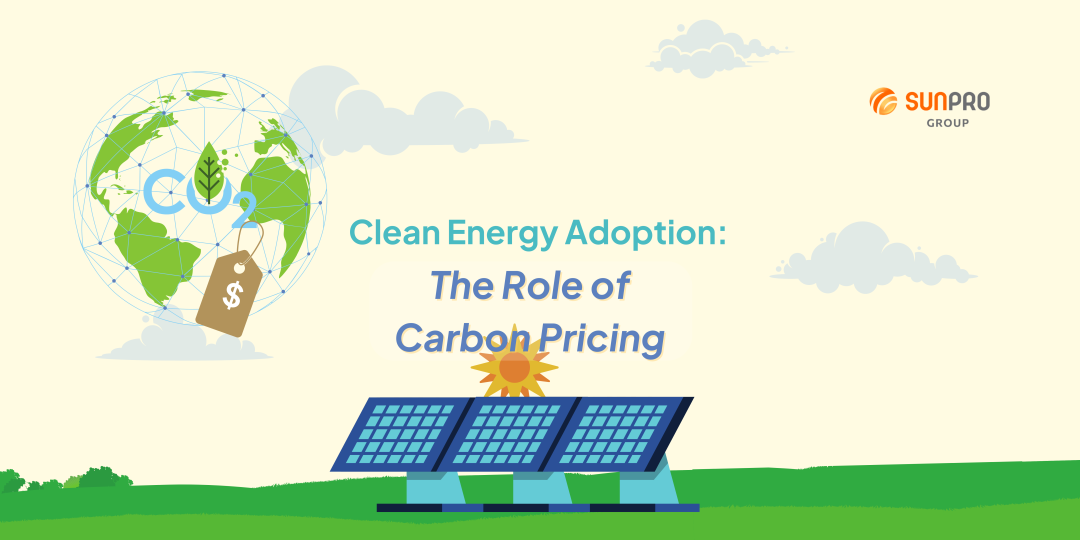
We have all heard of the term ‘Carbon Emissions’ being used frequently when it comes to the topic of Climate change, but how has Carbon Pricing got anything to do with the clean energy sector?
Join us as we uncover the different terms on carbon and why it is relevant to us under the solar industry! (*read till the end to find out the explanation of terms*)

Top 3 Markets and Notable Players in the APAC Region
As for the top three renewable energy markets in the APAC region, China takes the lead. It has the highest renewable energy market share, accounting for over 40% of the installed capacity in the region. The market for renewable energy in China is characterized by a dominant focus on wind and solar power. In fact, China is the largest producer of both. China Energy, State Power Investment Corporation, and China Guodian Corporation are the biggest players in China’s renewable energy market.
India comes in second as the largest renewable energy market in the APAC region. India’s total installed capacity stands at over 95 GW, and the country has set an ambitious target of achieving 175 GW of renewable energy capacity by 2022. Adani Green Energy, Tata Power, and ReNew Power are the dominant players in India’s renewable energy market.
In third place is Japan, boasting an immense installed capacity of over 57 GW. The land of the rising sun is paving the way in the renewable energy market, with a primary focus on solar power, and has set an ambitious target of achieving 24% of its energy mix from renewable sources by 2030. Leading the charge in the Japanese renewable energy market are the likes of SoftBank Group, Tokyo Electric Power Company, and JERA.
Up-and-Coming Markets and New Players to Look Out For
Vietnam, Australia, and South Korea are emerging as the exciting up-and-coming markets for renewable energy in the APAC region, with significant investment and promising growth projected in the years to come. These markets are characterized by growing energy demand, favorable government policies, and the influx of new players.
Vietnam, with an installed renewable energy capacity of over 10 GW, is shooting for the stars with a target of achieving 21% of its energy mix from renewable sources by 2030. The market is expected to soar to new heights, with a projected addition of over 23 GW of renewable energy capacity in the coming decade. Trungnam Group, AC Energy, and B.Grimm Power are the titans leading the way in this promising market.
Australia, with its wealth of natural resources like solar and wind power, has set its sights high, targeting a 50% renewable energy mix by 2030. The market is predicted to surge forward, with over 50 GW of renewable energy capacity projected to be added in the next decade. The likes of AGL Energy, Origin Energy, and Macquarie Group are the heavyweights leading the charge in the Australian renewable energy market.
Last but certainly not least, South Korea is making strides towards a cleaner energy future, with a target of achieving 20% of its energy mix from renewable sources by 2030. The market is expected to see an addition of over 30 GW of renewable energy capacity in the coming decade, with industry leaders such as Korea Electric Power Corporation, Hanwha Energy, and SK E&S leading the charge.
In summary, the renewable energy landscape in the APAC region is evolving at a breakneck pace. The market is dominated by industry titans such as state-owned companies, power utilities, and conglomerates, but new players like independent power producers and foreign investors are entering the fray, bringing with them fresh perspectives and innovative ideas. It is an exhilarating time for industry players and investors alike to capitalize on the vast opportunities that await in the quest for a cleaner and more sustainable energy future.
With Singapore being the first Southeast Asian country to introduce Carbon Pricing, on Tuesday, 1st January 2019, the Carbon Pricing Act (CPA) policy was started to encourage emissions reductions across all sectors and support the transition to a low-carbon economy. This has significant implications for the clean energy sector, making it an integral part of Singapore’s journey towards a sustainable future.

But how does having Carbon Pricing incentivise the adoption of Clean Energy sources like Solar power? By attaching a cost to carbon emissions, when companies or individuals are required to pay for their carbon emissions through taxes or carbon credit purchases, it becomes financially advantageous to reduce emissions. Solar power offers a practical solution for reducing carbon footprints.
Companies investing in solar energy not only decrease their emissions but also benefit from lower energy costs over time, contributing to long-term economic sustainability. However, challenges persist in terms of initial investment costs, energy storage, and integration into existing energy grids. Balancing these benefits and challenges is essential to accelerating the clean energy transition.

Global trends in Carbon Pricing have a profound impact on the solar and clean energy industry worldwide. As countries increasingly commit to reducing carbon emissions, Carbon Pricing mechanisms are gaining traction. This shift encourages greater investments in clean energy technologies like solar power.
Solar companies operating in regions with stringent Carbon Pricing policies can benefit from the growing demand for low-carbon energy sources. Furthermore, international efforts to establish carbon markets and trading systems provide opportunities for solar companies to engage in carbon credit trading, offering an additional revenue stream. Nonetheless, problems arise from varying Carbon Pricing policies, making it essential for solar companies to adapt to a complex regulatory landscape. Staying informed about these global trends is crucial for solar companies to navigate and capitalize on the evolving clean energy market.

Now, let’s delve into specific cases where Carbon Pricing has made a significant impact on clean energy strategies.
Among them are:
1. Sweden: The country’s carbon tax is one of the most successful carbon mechanisms globally. It has contributed to significant emissions reductions while driving investments in clean energy sources.
2. British Columbia, Canada: Its revenue-neutral tax is recognised for achieving carbon emission reductions without harming the economy. It’s often cited as a model for balancing environmental goals with economic interests.
3. Google: The company’s commitment to operating entirely on renewable energy and its investments in renewable energy projects showcase the proactive role that businesses can play in adopting Carbon Pricing internally. It highlights the potential for corporations to drive clean energy strategies through Carbon Pricing.
In Singapore, there are ongoing efforts to incorporate Carbon Pricing into clean energy and sustainability strategies. However, the country’s approach to Carbon Pricing is somewhat distinct from the examples I mentioned earlier. Singapore has introduced a carbon tax, which went into effect in 2019. This tax applies to large direct emitters of greenhouse gases, mainly in the industrial and energy sectors.
Singapore’s carbon tax is designed to encourage businesses to reduce their carbon emissions and adopt cleaner technologies. While Singapore doesn’t have a widespread carbon trading system like the European Union, it is actively working to improve energy efficiency and reduce emissions.
As global awareness of climate change intensifies and nations strive to meet ambitious emission reduction targets, the future of Carbon Pricing holds several promising prospects that could significantly impact the clean energy sector. :
i. Carbon Border Adjustments: In an effort to level the playing field for domestic industries and curb emissions leakage, countries are considering carbon border adjustments. These measures impose a carbon tariff on imports from countries with less stringent climate policies. For the clean energy sector, this could encourage domestic adoption of low-carbon technologies and further stimulate investments in clean energy, including solar.
ii. Technology Advancements: Advancements in carbon measurement and verification technologies, such as satellite-based monitoring, blockchain, and AI-driven carbon accounting, are set to transform the accuracy and efficiency of carbon pricing systems. These developments will facilitate transparent and credible carbon markets, thereby enhancing the value of clean energy solutions.
iii. Emission Trading Schemes (ETS): The expansion of emission trading systems across regions and nations is likely. This trend will encourage more companies to participate in carbon markets and stimulate investments in renewable energy, including solar. As carbon prices rise, the clean energy sector may become even more financially appealing.
iv. Carbon Capture and Utilization (CCU): The development of carbon capture and utilization technologies may not only reduce emissions but also create opportunities for businesses to generate carbon credits through the sequestration or use of captured carbon. This has the potential to open up new revenue streams for the clean energy sector.
In summary, Carbon Pricing is increasingly intertwined with the clean energy sector’s future. As nations grapple with the need to mitigate climate change and transition to low-carbon economies, carbon pricing serves as a powerful mechanism to incentivize clean energy adoption. Solar energy, in particular, stands to benefit significantly from the financial incentives created by Carbon Pricing.
Furthermore, as technology advances and global cooperation strengthens, the role of carbon pricing in driving the clean energy transition is expected to expand. Solar companies that adapt to the evolving Carbon Pricing landscape will be well-positioned to harness the opportunities and contribute to a more sustainable and resilient energy future.
Legend:
Carbon Tax; an environmental tax or penalty regulated by the government that organisations have to pay for their excessive production of carbon dioxide and other greenhouse gases.
Carbon Pricing; an approach to reducing carbon emissions (also referred to as greenhouse gas, or GHG, emissions) that uses market mechanisms to pass the cost of emitting on to emitters. Its broad goal is to discourage the use of carbon dioxide–emitting fossil fuels in order to protect the environment, address the causes of climate change, and meet national and international climate agreements.
Carbon Credit; a permit which allows a country or organization to produce a certain amount of carbon emissions and which can be traded if the full allowance is not used.
Carbon Credit Trading; reference v
(https://www.channelnewsasia.com/sustainability/cna-explains-carbon-trading-tax-climate-change-global-warming-3424796)
—
As we look to the future, we must all play a part in this vital transition. Explore solar energy options, advocate for clean energy policies, and be part of the solution. The power to create a more sustainable world is in your hands. Join us in embracing solar power and lighting the way toward a brighter future. Email us at info@sunproenergies.com to explore solar energy options today!

Accreditation


Commercial & Industrial

Residential

Internet of Energy

P +65 6612 5673
E info@sunprogroup.co
A 15 Kian Teck Drive. Singapore 628832
+65 6612 5673
info@sunprogroup.co
15 Kian Teck Drive. Singapore 628832

Accreditation

©2022 SunPro Group. Site by firefish.
WhatsApp us